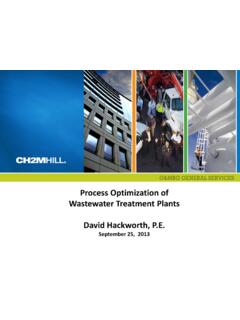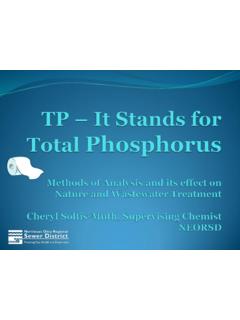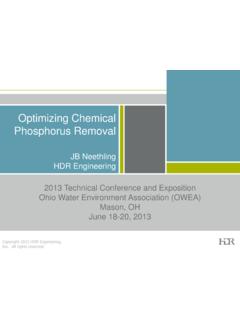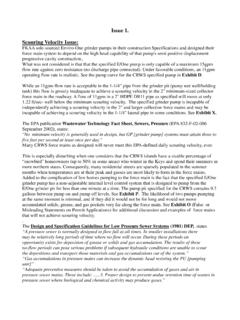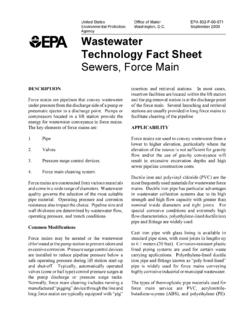Transcription of Low Velocities in Force Mains: Impacts and Solutions
1 Weftec 2011 Weftec 2011 Low Velocities in Force Mains: Impacts and Solutions Sean O Rourke, Bo Copeland, Weftec 2011 Low Velocities in Force Mains (FMs): Presentation Outline Overview Complications and consequences Contributing factors Standards and engineering practice Design and O&M Solutions Case studies Conclusion Questions Weftec 2011 Overview: Low Velocity in Force Mains Primary Concerns: deposition pocket accumulation (incl. air binding) / Biofilm accumulation Which can lead to: Pipe deterioration Reduced asset life Increased life-cycle cost Weftec 2011 Overview: Solid-liquid Horizontal Flow Behavior Behavior is dependent on fluid properties, velocity, particle sizes, density, etc.
2 Homogeneous suspension: Particles are uniformly suspended and move at the same velocity as the fluid. Heterogeneous suspension: A concentration gradient exists within the pipe as coarse particles move slower and begin to settle. Weftec 2011 Overview: Solid-liquid Horizontal Flow Behavior Heterogeneous flow can lead to solids deposition ( saltation regime ) Particles travel in discontinuous movements or by sliding/rolling along the bottom, if at all. Sliding bed Stationary bed Weftec 2011 Overview: Solid-liquid Horizontal Flow Behavior A sliding bed can cause abrasion of the pipe invert. Stationary beds reduce available pipe cross-sectional area. Goal: Operate at adequate velocity to achieve heterogeneous suspension without solids deposition Weftec 2011 Overview: Gas pocket accumulation (air binding) sewer gas can come out of solution within a FM and accumulate causing: 1.
3 Reduction in pipe cross-sectional area (increases pumping head) corrosion from H2S attack Weftec 2011 Additional Complications from Low Velocity in Force Mains In addition to solids deposition and accumulation of gas pockets, other complications may include: Grease / biofilm accumulation Microbial activity, H2S, odorous and corrosive conditions Weftec 2011 Common Consequences Associated with Low Velocity in FMs Potential consequences: Increased system head losses due to reduced cross-sectional area (smaller ID) and higher roughness factor Increased operating pressure (pump seals, piping, valves, and other appurtenances) Reduced pumping capacity Weftec 2011 Common Consequences Associated with Low Velocity in FMs Potential consequences (cont.)
4 : Increased odor and corrosion within the FM and downstream sewers and MHs Pipe abrasion (sliding bed or H2S attack) Increased O&M costs ( electrical use, chemical use, cleaning costs, etc.) Reduced asset life Weftec 2011 Additional Considerations (designers) Hazen-William s equation is only valid in transition zone not at velocity or diameter extremes (Moody chart) Weftec 2011 Contributing Factors Circumstances that may lead to low velocity: Small PSs with 4 FMs (80 gpm = ~2 fps) Existing FMs reused for smaller PSs Manifolded FMs serving multiple pump stations) Systems with no / low initial contributing flow (incl. phased developments) High wet-weather / average flow ratio High TDH (long FM or static head) Weftec 2011 Contributing Factors Circumstances that may lead to low velocity: PS down-sizing or other system changes Wear of pump components (impellers, volutes, etc.
5 Accumulation of gas pockets (air binding) in FM Increased system headlosses: oGrease accumulation oBiofilm growth resulting from use of ammonium calcium nitrate or certain other chemicals for odor and corrosion control in a long FM oFM relocations ( add length and fittings) Weftec 2011 Standards and Engineering Practice for Force main Velocity What Velocity is not Low Velocity ? Weftec 2011 Standards and Engineering Practice for Force main Velocity Ten States Standards (2004 ed.)1: At design pumping rates, a cleansing velocity of at least ft/s should be maintained. Pumping Station Design, (3rd ed.)3: The lowest design velocity .. for raw wastewater is 2 ft/s to keep grit moving, and a peak daily velocity of ft/s is desirable to resuspend settled solids.
6 Velocities as low as ft/s are tolerable with two daily flushes. If Velocities are < ft/s, a daily flush at ft/s long enough to sweep out the entire volume .. is desirable. Weftec 2011 Standards and Engineering Practice for Force main Velocity Piping Handbook (7th ed.)2: It is common practice to design sanitary sewers .. to provide for Velocities of 2 ft/s .. Storm sewers are commonly designed for a minimum full-flow velocity of 3 ft/s in order to resuspend sediment .. USEPA, wastewater technology fact sheet : Sewers, Force main (2000)4: Force mains .. are typically designed for Velocities between 2 to 8 ft/s. Weftec 2011 Standards and Engineering Practice for Force main Velocity Sanitary and Industrial wastewater Collection Pumping Stations and Force Mains, Department of the Army and Air Force (1985)5: Velocity criteria for Force mains are based on the fact that suspended organic solids do not settle out at a velocity >= fps.
7 Solids will settle at Velocities < fps .. However, a velocity of to fps is generally adequate to resuspend and flush the solids from the line. [For large pumping stations] it will generally be sufficient to design for Velocities of up to or fps. Weftec 2011 Standards and Engineering Practice for Force main Velocity Although general consensus is >~ ft/s to prevent deposition and ~ ft/s to resuspend solids, application varies between designers and projects Adjustable-speed pumps Multiple-pump systems Shared / manifolded Force mains Frequency of cleansing / scouring Weftec 2011 Standards and Engineering Practice for Force main Velocity Table B-9, Pumping Station Design, 3rd : Velocities Required to Scour Air Pockets from Pipelines.
8 Weftec 2011 Design Engineering Solutions : Proper hydraulic evaluation, incl. maintaining minimum velocity >=2 ft/s whenever possible Evaluation of alternate alignments and profiles Consideration of parallel pipes (if wide flow range) Proper air valve selection incl. avoiding air valves wherever feasible by avoiding intermediate high points and/or achieving air-scouring velocity Proper odor / corrosion control measures Weftec 2011 Design Engineering Solutions : Proper pump and impeller selection Evaluation of constant- vs. adjustable-speed pumps Appropriate pump controls auto-flushing Consideration of screening and grit removal Reducing amount of solids esp. grit and other large particles can reduce the required cleansing velocity Consideration of flushing and/or pig-launching and retrieval connections Weftec 2011 Operation and Maintenance (O&M) Solutions Regular flushing at higher velocity (auto or manual) Maintain pumps to preserve original pumping capacity debris-free, proper clearances, no blowby Refurbish or replace impellers as needed to maintain design (or higher) pumping capacity Change pump controls Weftec 2011 Operation and Maintenance (O&M) Solutions Chemical shocking to kill biofilm growth Mechanical Pipe Cleaning ( pigging) Odor / corrosion control chemical Weftec 2011 Operation and Maintenance (O&M)
9 Solutions ICE PIGGING by Utility Service Group Atlanta (currently up to 24-inch diameter) Weftec 2011 Case Study 1 Bromley & Taylorsport (Manifolded Force Mains) Weftec 2011 Case Study 1 Bromley & Taylorsport (Manifolded Force Mains) Portion with low C-factor Weftec 2011 Case Study 2 Gunpowder & Burlington (Manifolded Force main ) Weftec 2011 Case Study 2 Gunpowder & Burlington Force main Original Flow Direction New Flow Direction Weftec 2011 Case Study 2 Gunpowder & Burlington Force main Darker flow due to flow reversal in FM resuspending sedimentation Weftec 2011 Conclusion / Review Remember: Appropriate FM Velocities (~2 8 ft/s) Reasons why low Velocities are undesirable Potential complications and consequences Contributing factors to low Velocities Design and O&M Solutions Proper understanding allows: Engineers to make better design decisions Utility operators to better understand FM O&M issues Maximizing FM piping life and reducing life-cycle costs Weftec 2011 Questions?
10 (513) 469-2750 Weftec 2011 References Great Lakes-Upper Mississippi River Board of State and Provincial Public Health and Environmental Managers (2004) Recommended Standards for wastewater Facilities: Health Research Inc.: Albany, New York. , M. L. (2000) Piping Handbook, 7th ed.: McGraw-Hill: New York, New York. , G. M. (2008) Pumping Station Design, 3rd ed.: Elsevier, Inc.: Burlington, Massachusetts. (2000) wastewater technology fact sheet : Sewers, Force main : EPA 832-F-00-071. of the Army and the Air Force (1985) Sanitary and Industrial wastewater Collection Pumping Stations and Force Mains : Army TM 5-814-2, Air Force AFM 88-11, Vol. 2. , M. R. (2000) Minimum Velocity Required to Transport Solid Particles from the 2H-Evaporator to the Tank Farm : Westinghouse Savannah River Company: Aiken, South Carolina: WSRC-TR-2000-00263.
